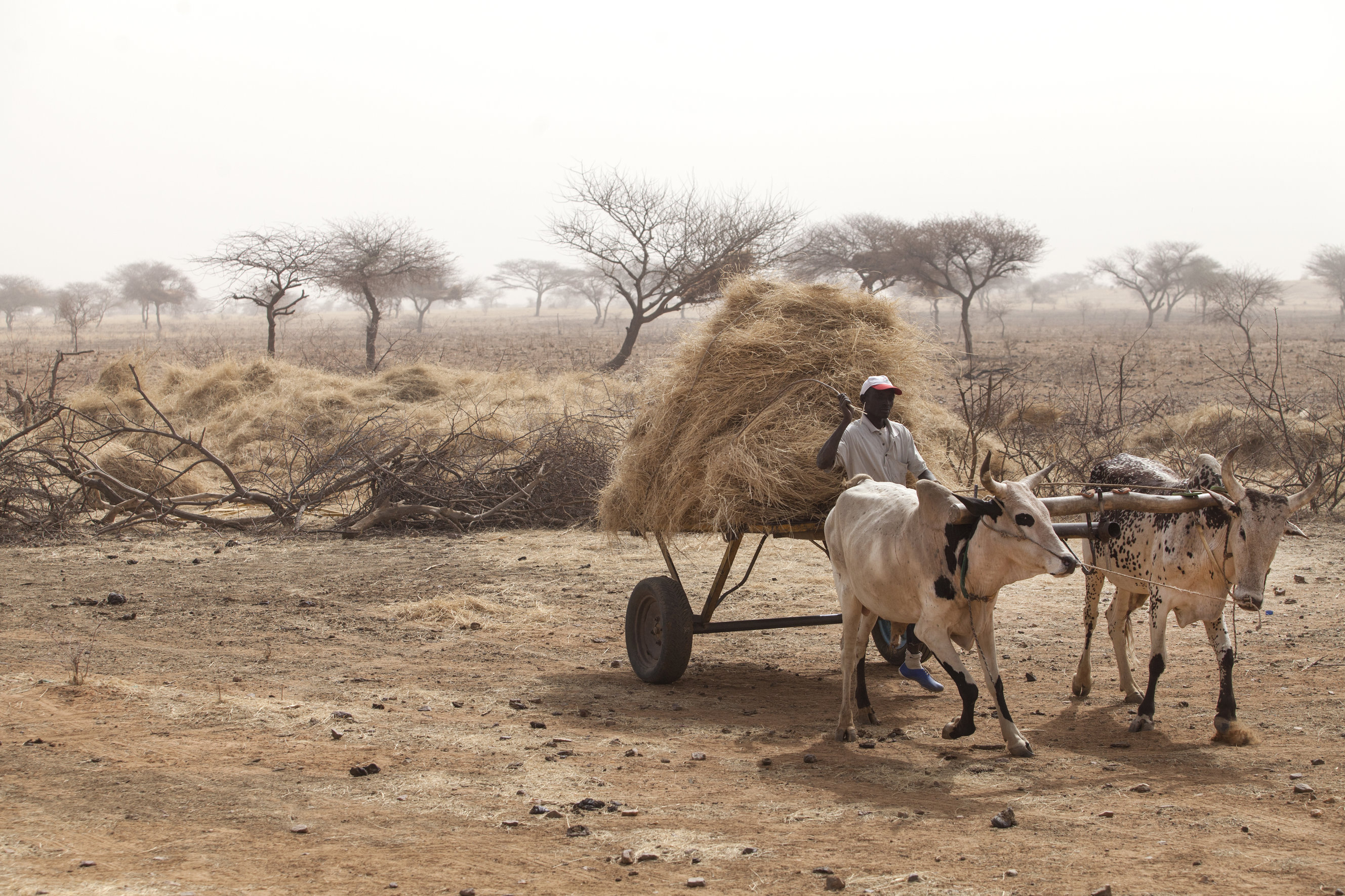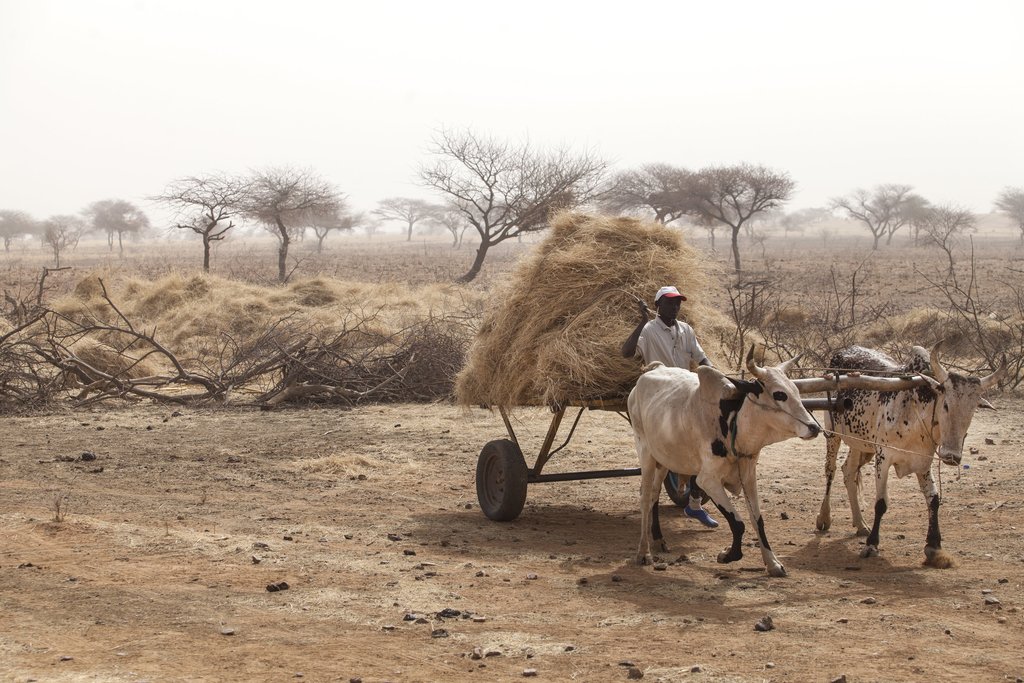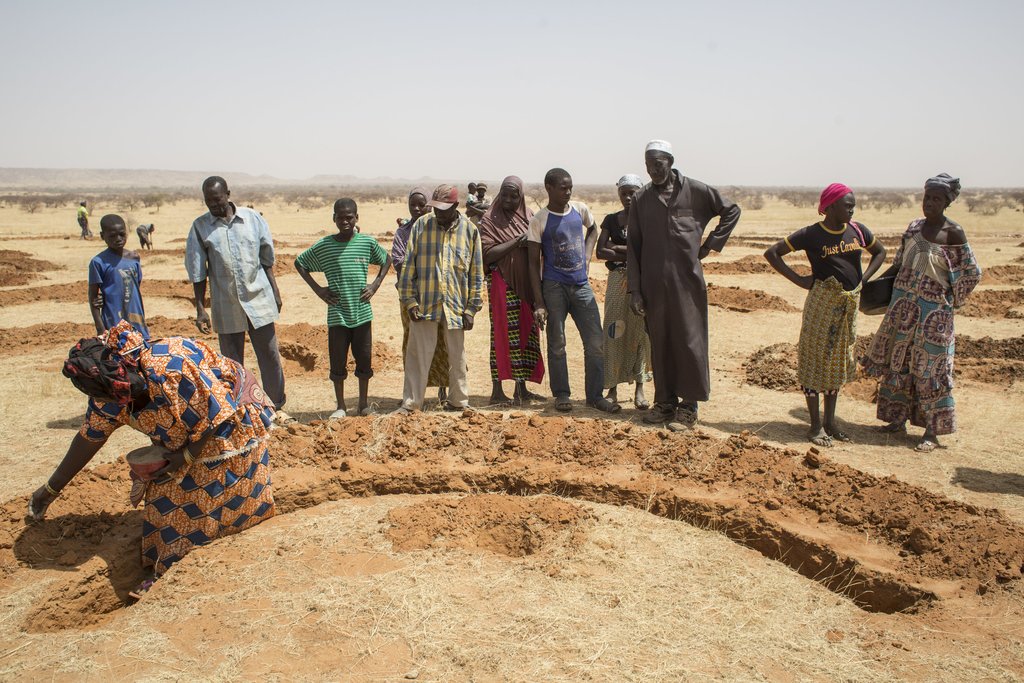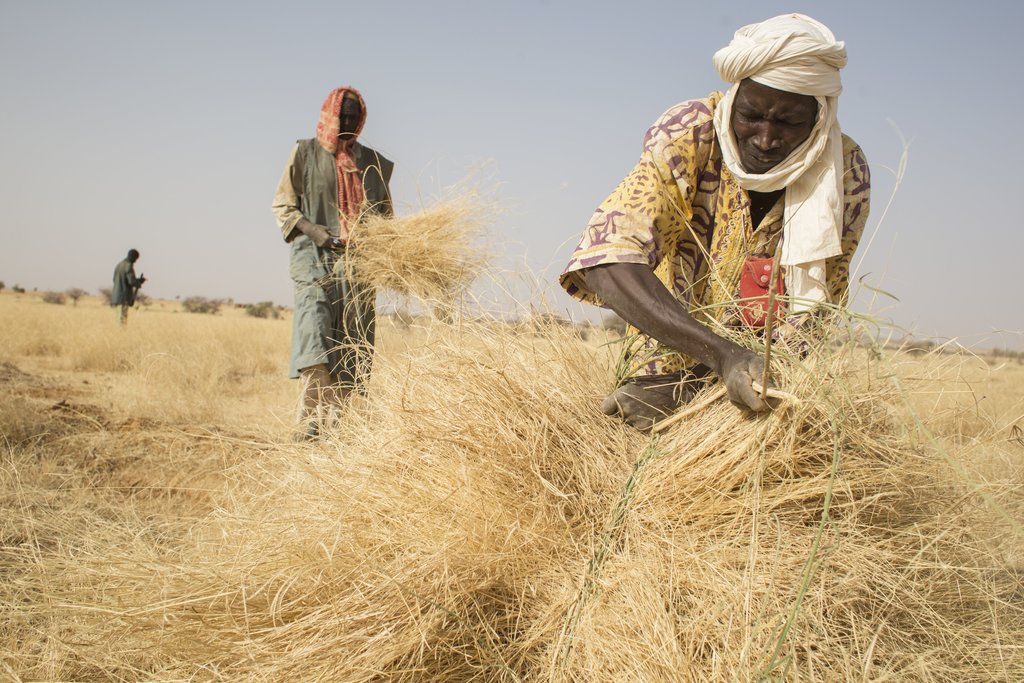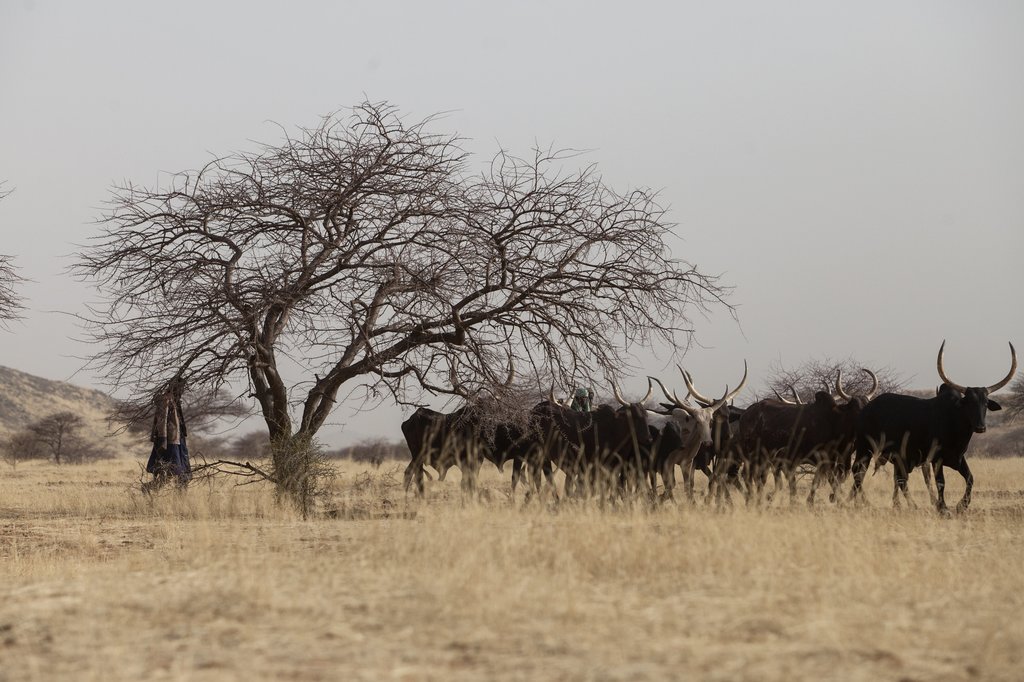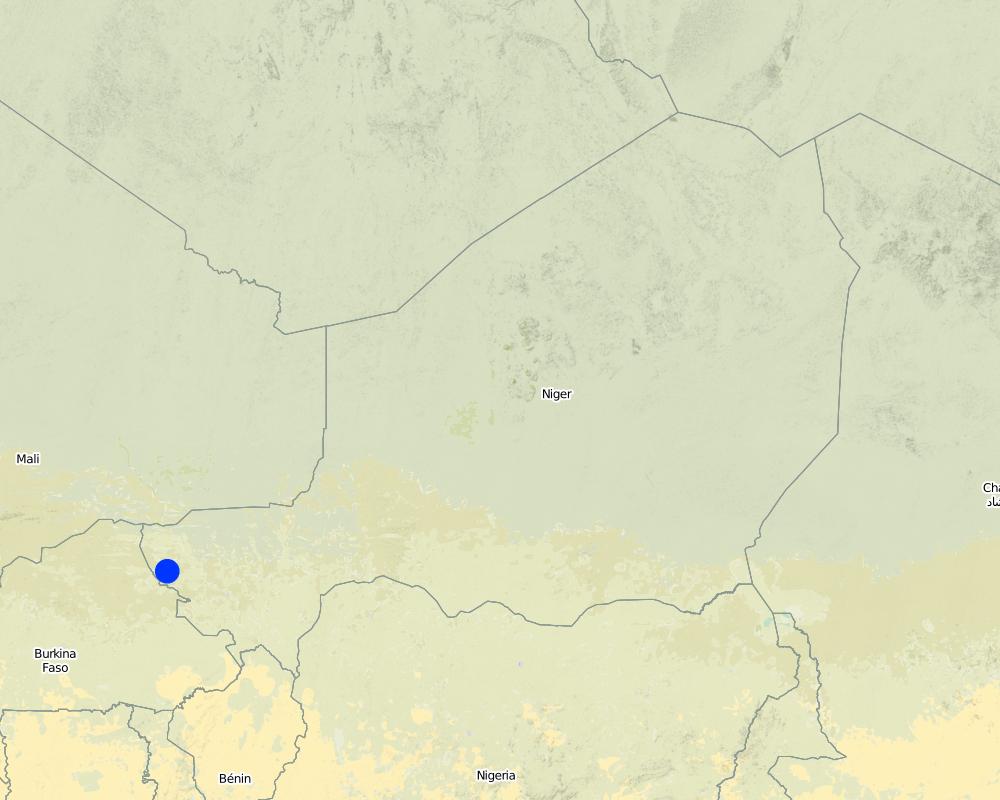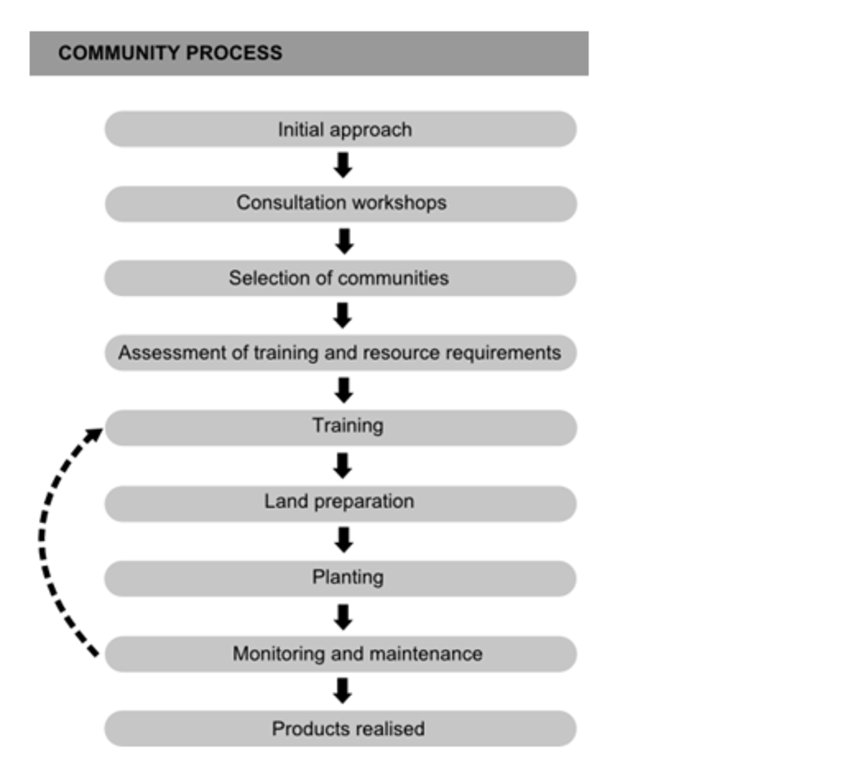Community participation in large-scale land restoration for Africa‘s Great Green Wall programme in Niger. [ไนเจอร์]
- ผู้สร้างสรรค์:
- การอัพเดท:
- ผู้รวบรวม: Vivian Onyango
- ผู้เรียบเรียง: –
- ผู้ตรวจสอบ: Rima Mekdaschi Studer
approaches_2909 - ไนเจอร์
- บทสรุปทั้งหมดในรูปแบบของ PDF
- บทสรุปทั้งหมดในรูปแบบของ PDF เพื่อพิมพ์
- บทสรุปทั้งหมดในรูปหน้าเว็บ
- บทสรุปทั้งหมด (ไม่มีการจัดเรียง)
- Community participation in large-scale land restoration for Africa’s Great Green Wall programme: 2 พฤศจิกายน 2021 (inactive)
- Community participation in large-scale land restoration for Africa’s Great Green Wall programme: 4 กรกฎาคม 2018 (inactive)
- Community participation in large-scale land restoration for Africa’s Great Green Wall programme : 13 พฤษภาคม 2018 (inactive)
- Community participation in large-scale land restoration for Africa’s Great Green Wall programme : 26 เมษายน 2018 (inactive)
- Community participation in large-scale land restoration for Africa‘s Great Green Wall programme in Niger.: 24 เมษายน 2018 (inactive)
- Community participation in large-scale land restoration for Africa’s Great Green Wall programme: 21 สิงหาคม 2024 (public)
ดูส่วนย่อย
ขยายทั้งหมด ย่อทั้งหมด1. ข้อมูลทั่วไป
1.2 รายละเอียดที่ติดต่อได้ของผู้รวบรวมและองค์กรที่เกี่ยวข้องในการประเมินและการจัดเตรียมทำเอกสารของแนวทาง
ผู้เชี่ยวชาญ SLM:
Sacande Moctar
moctar.sacande@fao.org
Forestry Policy and Resources Division (FOA)
อิตาลี
ชื่อของโครงการซึ่งอำนวยความสะดวกในการทำเอกสารหรือการประเมินแนวทาง (ถ้าเกี่ยวข้อง)
FAO-Action Against Desertificationชื่อของโครงการซึ่งอำนวยความสะดวกในการทำเอกสารหรือการประเมินแนวทาง (ถ้าเกี่ยวข้อง)
Food and Agriculture Organization of the United Nations (FAO) - อิตาลี1.3 เงื่อนไขที่เกี่ยวข้องกับการใช้ข้อมูลที่ได้บันทึกไว้ผ่านทาง WOCAT
ผู้รวบรวมและวิทยากรหลักยอมรับเงื่อนไขเกี่ยวกับการใช้ข้อมูลที่ถูกบันทึกผ่านทาง WOCAT:
ใช่
2. คำอธิบายของแนวทาง SLM
2.1 การอธิบายแบบสั้น ๆ ของแนวทาง
The Food and Agriculture Organization of the United Nations (FAO) has been implementing a participatory approach to implement large-scale restoration of degraded land in the Sahel, by placing rural communities at the center. In the framework of the Great Green Wall initiative, well adapted useful native species of trees, shrubs, and fodder grasses are planted in agro-sylvo-pastoral land that responds to community needs and preferences and at the same time to the ecological suitability.
2.2 การอธิบายอย่างละเอียดของแนวทาง
การอธิบายอย่างละเอียดของแนวทาง:
The approach is implemented under FAO's Action against Desertification (AAD) programme in the Great Green Wall for the Sahara and the Sahel (GGWSSI); Africa's flagship initiative to combat the effects of climate change and desertification, and address food insecurity and poverty, bringing together more than 20 African countries with international organizations, research institutes, civil society and grassroots organizations. Through the GGWSSI, the vision is a mosaic of sustainable land use practices and productive landscapes across North Africa, the Sahel and the Horn.
Community participation in the Great Green Wall Restoration is a people-centered approach to rangeland management that puts communities at the heart of restoration efforts and focusses on their needs for useful plant species such as well-adapted native trees, shrubs and fodder grasses with a high resilience to drought and preferences for restoration in support of their livelihoods. Village communities decide on lands and on diverse species that they can use for food, to feed animals, for medical care and to produce economically valuable goods for local, national and even international markets, such as gum Arabic for example. Technically, AAD support the implementation of land restoration activities through provision of necessary equipment and strengthening the technical and functional capacities of individuals, communities, and organizations in restoration techniques and sustainable land management.
The main objectives of this approach are:
a) Poverty alleviation;
b) Ending hunger;
c) Improving resilience to climate change using a landscape approach.
The restoration approach is based on a five-step model:
• Communities: needs and requirements for restoration are determined through in-depth consultations with communities.
• Research: the quality seed is made available for the propagation of economically viable, locally adapted and bio-diverse material.
• Operational procedure: ensuring efficient operational restoration processes, including land preparation and management, assisted natural regeneration and planting.
• Monitoring: evaluating the field performance of species, as well as communal activities such as maintenance and management of restored areas.
• Capacity development: develop village technicians’ capacities in forest seed collecting and nursery techniques, planting, maintenance and management of restored areas, and development of plant products, marketing, and local business management.
2.3 รูปภาพของแนวทาง
ข้อสังเกตทั่วไปเกี่ยวกับรูปภาพ:
The photos were taken under the FAO project GCP/INT/157/EC: Action Against Desertification is an initiative of the African, Caribbean and Pacific Group of States (ACP) to promote sustainable land management and restore drylands and degraded lands in Africa, the Caribbean and the Pacific, implemented by FAO and partners with funding from the European Union in the framework of the 10th European Development Fund (EDF).
2.4 วีดีโอของแนวทาง
ความคิดเห็น อธิบายสั้นๆ:
https://www.youtube.com/watch?v=qVcMSeXZnJI
Over the next decade, 50 million people may be displaced by desertification - the result of climate change and the depletion of natural resources. Action Against Desertification, an initiative of the African, Caribbean, and Pacific Group of States is implemented by the Food and Agriculture Organization of the United Nations with the financial contribution of the European Union. It aims to restore the productivity of degraded forests and landscapes and enhance the resilience of people to climate change in 6 Great Green Wall countries in Africa as well as Haiti in the Caribbean and Fiji in the Pacific.
วันที่:
02/12/2015
สถานที่:
Rome
ชื่อของผู้ถ่ายวีดีโอ:
© FAO
ความคิดเห็น อธิบายสั้นๆ:
https://www.youtube.com/watch?v=prl1eaSvQCQ&feature=youtu.be
Land restoration in the Sahel is making degraded areas productive again, providing economic opportunities in a region where migration has become a tradition. Under FAO’s “Action Against Desertification” programme, these efforts are being expanded to six African countries. Land degradation around the Sahara is not yet irreversible.
วันที่:
18/07/2016
สถานที่:
Rome
ชื่อของผู้ถ่ายวีดีโอ:
© FAO
2.5 ประเทศ ภูมิภาค หรือสถานที่ตั้งที่ได้นำแนวทางไปใช้
ประเทศ:
ไนเจอร์
ภูมิภาค/รัฐ/จังหวัด: :
Tillabery, Dosso and Tahoua
ข้อมูลเฉพาะเพิ่มเติมของสถานที่ตั้ง:
In Niger, the GGW covers all the eight Regions of the countries. Currently FAO’s Action Against Desertification project works in three Regions including Tillabery, Dosso and Tahoua, though the approach is used and expanding to all of the remaining 5 Regions, which are also implementing the GGW restoration programme.
ความคิดเห็น:
The AAD land restoration approach has been successfully implemented with trans-boundary interventions in Niger, Burkina Faso, and Mali. For this documentation, the focus is on Tera, Niger.
Map
×2.6 วันที่เริ่มต้นและสิ้นสุดของแนวทาง
ระบุปีที่เริ่ม:
2013
2.7 ประเภทของแนวทาง
- ใช้โครงงานหรือแผนงานเป็นฐาน
2.8 เป้าหมายหรือวัตถุประสงค์หลักของแนวทาง
Key elements and aim of this approach include:
• That the right species planted in the right place.
• Promote the use of quality native forest and fodder seeds for restoration.
• Ensuring that a wide range of useful plant species is used or made available for use.
• Managing natural regeneration of species and planted areas through village management committees.
• Updating a species database for gene-pool traceability, monitoring, reporting and for future uses of data and information.
2.9 เงื่อนไขที่เอื้ออำนวยหรือเป็นอุปสรรคต่อการนำเทคโนโลยีภายใต้แนวทางนี้ไปปฏิบัติใช้
บรรทัดฐานและค่านิยมทางสังคม วัฒนธรรม ศาสนา
- เอื้ออำนวย
The approach is people centered and builds up on traditional management of land and traditional ecological knowledge and techniques such as half-moon for rain water harvesting that facilitates improved seedling and crop establishment.
การมีไว้ให้หรือการเข้าถึงแหล่งการเงินและบริการ
- เอื้ออำนวย
Individuals can use finances to buy seeds. At community land, finances maybe needed to lease land needed for production of plant varieties needed, for hiring labour to take care of seedlings.
การจัดตั้งระดับองค์กร
- เอื้ออำนวย
Better organization at local level enhances community participation and commitment to realize the interventions at large scale/community level.
การร่วมมือหรือการทำงานประสานกันของผู้ลงมือปฏิบัติ
- เอื้ออำนวย
There are various levels of collaboration needed for example in establishing land, in seed selection based on desired needs and also on labour provision.
Fundamentally, collaboration is key to agreeing on desired objectives.
กรอบแนวทางในการดำเนินการด้านกฎหมาย (การถือครองที่ดิน สิทธิในการใช้ที่ดินและน้ำ)
- เอื้ออำนวย
Secure access rights to land and water resources is a motivation for investing in reforestration.
นโยบาย
- เอื้ออำนวย
national level policies can protect and ensure supply of seeds and seed varieties as well as access to natural resources such as land.
Additionally, policies such as those in support for Great Green Wall activities create an enabling environments on which these activities can be supported and take place.
การกำกับดูแลที่ดิน (การตัดสินใจ การนำเอาไปปฏิบัติใช้ และการบังคับใช้)
- เอื้ออำนวย
Similar to legal framework above.
ความรู้เกี่ยวกับ SLM การเข้าถึงการสนับสนุนด้านเทคนิค
- เอื้ออำนวย
Knowledge around SLM contributes to maintenance and management of restored areas thus ensuring sustainability of activities. The programme has integrated existing/traditional SLM activities such as zaï/half-moon in capturing, retaining and saving water thus keeping soils moisturized and giving plants a chance to grow in an otherwise very dry environment.
ตลาด (จัดซื้อปัจจัยนำเข้า ขายผลิตภัณฑ์) และราคา
- เอื้ออำนวย
Market access and increasing economic capacities of communities can enable active involvement in restoration especially when plant products can earn income thus facilitating local business management.
ปริมาณงานที่ทำได้ กำลังคนที่มีให้
- เอื้ออำนวย
Availability of labour facilitates activities such as forest seed collecting, nursery techniques, planting, maintenance and management of restored areas. Most of the work is done by women who prepare the soils and lead planting.
3. การมีส่วนร่วมและบทบาทของผู้มีส่วนได้ส่วนเสียที่เกี่ยวข้อง
3.1 ผู้มีส่วนได้ส่วนเสียที่เกี่ยวข้องในแนวทางนี้และบทบาท
- ผู้ใช้ที่ดินระดับท้องถิ่นหรือชุมชนระดับท้องถิ่น
Total project beneficiaries are 116,000 people (with over half women)
Age groups varied from 15 to 70 years.
Participants were villages including farmers, herders, traditional healers and herbalists.
Each intervention village has a village management committee set up for the GGW implementation activities. They contribute land and labour and village technicians are trained in large scale degraded land restoration techniques so that they can be self-sufficient at the end of the funding.
1. Defining needs, preferences of species and objectives for land restoration in degraded lands.
2. Trained on collection of seeds and on how to produce seedlings in village nurseries.
3.The involved communities also participated in the regular monitoring and evaluation of plots.
4. Participating in workshops including to agree on work plans
5. Communities were also source of rich traditional ecological knowledge
6. Supporting project through in-kind contributions such as labour and land
7. Representation in the steering committee
- องค์กรที่ขึ้นอยู่กับชุมชน
Each intervention village has a village management committee set up for the GGWSSI implementation activities
- Contibute land, labour and village technicians to be trained on large scale land restoration techniques geared at self-sufficiency at the end of project life.
-Managing intervention sites including products such as fodder
-Collaborating with national and local administration
- ผู้เชี่ยวชาญ SLM หรือที่ปรึกษาการเกษตร
Support to identification of land needed for restoration, seeds and management objectives of restoration.
- นักวิจัย
National seed centres.
1. Address the availability of good quality seeds for collection
2. Ensuring genetic diversity reflecting original provences of native species.
- องค์กรพัฒนาเอกชน
Local NGOs and CBOs.
Local NGO's were trained on land restoration activities.
NGOs were also instrumental in discussions on scaling up the approaches and policy support for mainstreaming sustainable land management .
- ภาคเอกชน
Supplies of equipment and materials needed for restoration activities.
Mainly business related to procurement of goods and services.
- รัฐบาลระดับท้องถิ่น
Local administration and national governments in the respective countries.
1. provide technical management and management if the operational team.
2. Mobilization of communities.
3. Part of the steering committee.
- รัฐบาลแห่งชาติ (ผู้วางแผน ผู้ทำการตัดสินใจ)
1. Ministry of Environment and Sustainable Development.
2. National Agency of the Great Green Wall.
3. National Forestry Seed Centre.
4. Local authorities (i.e. Mairies or Town halls) involved in Tillabery, Dosso and Tahoua regions.
- องค์การระหว่างประเทศ
Royal Botanical Garden, Kew.
Technical support; botanical knowledge and information resources, and identifying priority species for the Great Green Wall.
3.2 การเกี่ยวข้องของผู้ใช้ที่ดินระดับท้องถิ่นหรือชุมชนระดับท้องถิ่นในช่วงต่างๆของแนวทาง
| ความเกี่ยวข้องของผู้ใช้ที่ดินระดับท้องถิ่นหรือชุมชนระดับท้องถิ่น | ระบุผู้ที่มีส่วนเกี่ยวข้องและอธิบายกิจกรรม | |
|---|---|---|
| การริเริ่มหรือการจูงใจ | ปฏิสัมพันธ์ | Communities local knowledge, needs and aspirations were the back-borne of the project. Communities were extensively consulted on species identification and prioritization based on needs including speed of return of products for the local communities, personal knowledge and inspirations. This was through questionnaires and village workshops. I bigger commitment and buy-in from the community was also a prerequisite for activities to start as they had to commit to contribute land and labour in-kind. As a matter of fact, selection of villages for restoration was based on among other things motivation and commitment by communities to participate in restoration activities. and community based structures and organization. |
| การวางแผน | ปฏิสัมพันธ์ | Extensive planning was done with communities before implementation e.g. to agree on planting time ( at onset of rains), use of traditional techniques and land scarification. |
| การดำเนินการ | ปฏิสัมพันธ์ | Implementation was done actively with communities who volunteered traditional knowledge and labour to the activities. This had built on the initiation; where species were selected and prioritized, planning of activities and later labour in preparation of land, setting up nurseries and trans-planting. |
| การติดตามตรวจสอบหรือการประเมินผล | ปฏิสัมพันธ์ | Monitoring and field data collection on survival and growth of seedlings were carried out by trained village technicians in collaboration with the communities and technical institutions. |
3.3 แผนผังแสดงขั้นตอนการทำงาน (ถ้ามี)
3.4 การตัดสินใจเลือกใช้เทคโนโลยี SLM
ระบุผู้ที่ทำการตัดสินใจเลือกเทคโนโลยีมากกว่าหนึ่งวิธีไปปฏิบัติใช้:
- ผู้ลงมือปฏิบัติที่เกี่ยวข้องทั้งหมดในฐานะที่เป็นส่วนรวมของแนวทาง
การอธิบาย:
This is a local initiative that uses traditional ecological knowledge and multi-purpose plant species (of known benefits to the local communities) for restoration.
Community participation, lifestyles and preferences and a careful analysis of ecological landscapes are carefully considered and then matched to suitable interventions. This similar approach has been applied by other projects in the GGWSSI region however although has not often been formally disseminated to wider audiences.
ระบุว่าการตัดสินใจตั้งอยู่บนพื้นฐานของ:
- การประเมินความรู้ SLM ที่ได้ทำการบันทึกไว้เป็นอย่างดี (การใช้ข้อมูลในการตัดสินใจ)
- สิ่งที่ค้นพบจากงานวิจัย
- ประสบการณ์และความคิดเห็นส่วนตัว (ไม่ได้ลงบันทึกไว้)
4. การสนับสนุนด้านเทคนิค การสร้างขีดความสามารถ และการจัดการด้านความรู้
4.1 การสร้างขีดความสามารถ / การอบรม
ได้มีการจัดอบรมให้แก่ผู้ใช้ที่ดินหรือผู้มีส่วนได้ส่วนเสียคนอื่น ๆ หรือไม่:
ใช่
ให้ระบุว่าใครเป็นผู้ได้รับการอบรม:
- ผู้ใช้ที่ดิน
- เจ้าหน้าที่ภาคสนาม / ที่ปรึกษา
ถ้าเกี่ยวข้อง ให้ระบุ เพศ อายุ สถานภาพ ชาติพันธุ์ เป็นต้น:
100 small-scale farmers were trained in 2017, in Natural Assisted Regeneration techniques and 40 farmers were trained in forest and fodder seed collection and the production of seedlings in village nurseries and in the management of planted sites.
รูปแบบการอบรม:
- จัดคอร์ส
หัวข้อที่พูด:
Technical training was provided to villages in formal modules on how to collect quality seeds in defined seed zones. The training was provided by the national forest seed centres . The trainings were on seedling production and participatory forest management . Other areas covered included; added-value and the development of plant products (non-timber forest products), marketing and local business management to support income generation.
ความคิดเห็น:
Apart from the restoration technical areas covered above, additional areas of training included; improving adult literacy, family health and nutritional standards. This was done together with specialized rural sector developers.
4.2 การบริการให้คำแนะนำ
ผู้ใช้ที่ดินมีการเข้าถึงการรับบริการให้คำปรึกษาหรือไม่:
ใช่
ระบุว่ามีบริการให้คำปรึกษาหรือไม่:
- ไปเยี่ยมชมสถานที่
- ที่ศูนย์ถาวร
- workshops
การอธิบาย/แสดงความคิดเห็น:
To re-introduce plant for large-scale restoration, effective use of seeds of wild species demands sufficient biological and technical knowledge on a big number of species to allow for collection, storage and germination of seeds and establishment of seedlings. In this approach therefore, the technical know-how of RBG Kew and related partnership with forest seed centres that allowed for collection of quality seeds.
4.3 การเสริมความแข็งแกร่งให้กับสถาบัน (การพัฒนาองค์กร)
สถาบันได้รับการจัดตั้งขึ้นมาหรือเสริมความแข็งแกร่งโดยแนวทางนี้หรือไม่:
- ใช่ อย่างมาก
ระบุระดับของสถาบันที่ได้รับการเสริมความแข็งแกร่งหรือจัดตั้งขึ้นมา:
- ท้องถิ่น
- ภูมิภาค
- ประเทศ
อธิบายถึงสถาบัน บทบาทและความรับผิดชอบ สมาชิก เป็นต้น:
Institutions: National government; NGOs, CBOs,
Support to the national government who is the national agency for the GGW is the entry point. Through them ad based on national objectives, the project moves to a decentralized level. At the national level, capacities have been improved on monitoring and evaluation techniques; seed identification and selection and handling.
Local level: these are the implementing partners and do work on the ground. Their capacities have been improved on seed selection and restoration techniques and on data collection
Regional level: more collaboration, coordination and knowledge sharing on the GGW initiatives as well as peer to peer learning.
ระบุประเภทของการให้ความช่วยเหลือสนับสนุน:
- ด้านการเงิน
- การสร้างขีดความสามารถ / การอบรม
- อุปกรณ์
ให้รายละเอียดเพิ่มเติม :
Equipment: mainly for land preparation for planting and non-timber forest processing.
4.4 การติดตามตรวจสอบและประเมินผล
การติดตามตรวจสอบและประเมินผลเป็นส่วนหนึ่งของแนวทางหรือไม่:
ใช่
ความคิดเห็น:
Regular monitoring is carried out by village communities involved in the restoration exercise. The activities include assessing seedling survival and growth and planted surface areas.
ถ้าตอบว่าใช่ แสดงว่าการจัดเตรียมเอกสารนี้มุ่งหวังที่จะเอาไปใช้สำหรับการติดตามตรวจสอบและประเมินผลใช่หรือไม่:
ไม่ใช่
4.5 การวิจัย
การวิจัยเป็นส่วนหนึ่งของแนวทางหรือไม่:
ใช่
ระบุหัวข้อเรื่อง:
- สังคมวิทยา
- เศรษฐศาสตร์หรือการตลาด
- นิเวศวิทยา
ให้ข้อมูลเพิ่มเติมและให้ระบุผู้ทำการวิจัย:
Through a questionnaire, communities define their needs and preferences of species, the objectives of land restoration in their available agro-sylvo-pastoral degraded lands. Results of this consultation are fed back to them after analyses by the project team (researchers, plant expertise, seed centres) for the feasibility, suitability and availability of the requested species. This allows commonly to agree on interventions, priorities and implementation plans with roles and responsibility from the communities as well as from the technical teams.
1. Sociology: prior research was done on social diversity of village communities on areas such as gender, age, profession among others to decide on village selections but also ensure required balance.
2. Economics/marketing: This was multi-faceted on one hand looking at community economic needs and priorities and also on how to value addition to non-timber forest products. The plant-use data received from respondents were classified according to the Economic Botany Data Collection.
These helped in deciding and prioritizing species according to community needs.
3. Ecology: GGW initiative is typically for drylands with challenges such as moisture retention. Thus the ecology of the place was studied to identify suitable plant species that would thrive under these conditions of course in combination with traditional technologies that have been developed to overcome the moisture deficits.
The botany of selected species was further examined in laboratories to first of all check their suitability to dryland environments and thereafter to ensure good quality seeds are used including ensuring genetic diversity
5. การสนับสนุนด้านการเงินและวัสดุอุปกรณ์
5.1 ระบุงบประมาณประจำปีสำหรับแนวทาง SLM นี้
ถ้าหากว่างบประมาณประจำปีไม่เป็นที่ทราบแน่นอน ให้ระบุช่วงลงไป:
- 10,000-100,000
แสดงความคิดเห็น (แหล่งของการระดมทุน ผู้บริจาคคนสำคัญ):
Action Against Desertification is implemented by FAO and partners with funding from the European Union in the framework of the 10th European Development Fund (EDF). The GGWI under AAD in Niger is funded up to around 1.5m USD for the four years of the project.
5.2 การสนับสนุนด้านการเงิน / วัสดุอุปกรณ์ให้แก่ผู้ใช้ที่ดิน
ผู้ใช้ที่ดินได้รับการสนับสนุนด้านการเงิน / วัสดุอุปกรณ์ไปปฏิบัติใช้เทคโนโลยีหรือไม่:
ใช่
ถ้าใช่ ให้ระบุประเภทของการสนับสนุน เงื่อนไขและผู้จัดหามาให้:
Finances are needed for purchasing equipment, seeds were also provided, seed testing to establish the desired type/species.
5.3 เงินสนับสนุนสำหรับปัจจัยนำเข้า (รวมถึงแรงงาน)
- แรงงาน
| เห็นด้วยระดับไหน | ระบุเงินสนับสนุน |
|---|---|
| ได้รับการช่วยเหลือทางการเงินบางส่วน | Local communities shared some tasks such as during planting period the project provided lunch. |
- อุปกรณ์
| ระบุปัจจัยนำเข้าที่ได้รับการสนับสนุน | เห็นด้วยระดับไหน | ระบุเงินสนับสนุน |
|---|---|---|
| เครื่องจักร | ได้รับการช่วยเหลือทางการเงินบางส่วน | Provided such as arable tools, carts for transportation. |
| เครื่องมือ | ได้รับการช่วยเหลือทางการเงินบางส่วน | Arable tools for planting. |
- การเกษตร
| ระบุปัจจัยนำเข้าที่ได้รับการสนับสนุน | เห็นด้วยระดับไหน | ระบุเงินสนับสนุน |
|---|---|---|
| เมล็ด | ได้รับการช่วยเหลือทางการเงินบางส่วน | Training was provided on a collection of native forest seeds that were then bought from them (communities thus earning an income for communities). |
| Organic manure | Training to do and collect composts. | |
- วัสดุสำหรับการก่อสร้าง
| ระบุปัจจัยนำเข้าที่ได้รับการสนับสนุน | เห็นด้วยระดับไหน | ระบุเงินสนับสนุน |
|---|---|---|
| หิน | ได้รับการช่วยเหลือทางการเงินบางส่วน | For storage facilities. |
ถ้าแรงงานโดยผู้ใช้ที่ดินเป็นปัจจัยนำเข้าที่มีอยู่มากมาย ระบุด้วยว่าเนื่องจาก:
- ให้ค่าตอบแทนด้วยการสนับสนุนด้านวัสดุอุปกรณ์อื่น ๆ
ความคิดเห็น:
In partnership with WFP there was collaboration on food for assets and incentives from the project such as trainings on preparation of vegetable gardens..
5.4 เครดิต
มีการจัดหาเครดิตมาให้ภายใต้แนวทาง SLM หรือไม่:
ไม่ใช่
5.5 แรงจูงใจหรือเครื่องมืออื่น ๆ
แรงจูงใจหรือเครื่องมืออื่น ๆ ได้ถูกนำไปใช้ส่งเสริมการใช้เทคโนโลยี SLM หรือไม่:
ใช่
ถ้าใช่ ระบุ:
Functional capacity building village communities for example in management of restoration sites and development of community forest products
6. การวิเคราะห์ผลกระทบและการสรุป
6.1 ผลกระทบของแนวทาง
ทำให้ผู้ใช้ที่ดินระดับท้องถิ่นมีอำนาจขึ้น ปรับปรุงการเข้าร่วมของผู้มีส่วนได้ส่วนเสียให้ดีขึ้นหรือไม่:
- ไม่ใช่
- ใช่ เล็กน้อย
- ใช่ ปานกลาง
- ใช่ อย่างมาก
The project supports the communities to improve productivity of their land in direct consultation with them while benefiting from trainings with changes recorded in diversity of biomass in community plots and lands.
ช่วยในการตัดสินใจโดยดูจากหลักฐาน ได้หรือไม่:
- ไม่ใช่
- ใช่ เล็กน้อย
- ใช่ ปานกลาง
- ใช่ อย่างมาก
Substantial improvement is already recorded on state of land in the last 2 years.
ช่วยให้ผู้ใช้ที่ดินนำเอาเทคโนโลยี SLMไปใช้และบำรุงรักษาสภาพไว้ได้หรือไม่:
- ไม่ใช่
- ใช่ เล็กน้อย
- ใช่ ปานกลาง
- ใช่ อย่างมาก
Trainings were provided on various aspects such as seed selection and collection.
ปรับปรุงความร่วมมือกันและการดำเนิน งานของ SLM ได้อย่างมีประสิทธิผลหรือไม่:
- ไม่ใช่
- ใช่ เล็กน้อย
- ใช่ ปานกลาง
- ใช่ อย่างมาก
The project is not funding all aspects yet building sustainability through the direct capacity development and participation by communities.
ระดมกำลังหรือปรับปรุงการเข้าถึงแหล่ง เงินทุนสำหรับการดำเนินการ SLM หรือไม่:
- ไม่ใช่
- ใช่ เล็กน้อย
- ใช่ ปานกลาง
- ใช่ อย่างมาก
1. Village technicians have been used by other projects in the area in SLM and also by the government while getting remuneration. 2. Communities are able to sell native restoration seeds to other projects in the region and to the government.
ปรับปรุงความรู้และความสามารถของผู้ใช้ที่ดินในการดำเนินการ SLM หรือไม่:
- ไม่ใช่
- ใช่ เล็กน้อย
- ใช่ ปานกลาง
- ใช่ อย่างมาก
Through trainings and capacity development e.g. on large-scale land preparation for planting and seed selection.
ปรับปรุงความรู้และความสามารถของผู้มีส่วนได้ส่วนเสียคนอื่น ๆ ให้ดีขึ้นหรือไม่:
- ไม่ใช่
- ใช่ เล็กน้อย
- ใช่ ปานกลาง
- ใช่ อย่างมาก
1. Governments; training of technicians including on specialized tools, training on monitoring and evaluation of SLM and restoration impacts. 2. CBOs and local administrations. regional organizations such as CILSS-Agryhmet were also trained on the above.
ทำให้ผู้ใช้ที่ดินระดับท้องถิ่นมีอำนาจขึ้น ปรับปรุงการเข้าร่วมของผู้มีส่วนได้ส่วนเสียให้ดีขึ้นหรือไม่:
- ไม่ใช่
- ใช่ เล็กน้อย
- ใช่ ปานกลาง
- ใช่ อย่างมาก
The village technicians and trained seed collectors are now organized in a regional union for restoration seed supply.
ช่วยบรรเทาความขัดแย้งหรือไม่:
- ไม่ใช่
- ใช่ เล็กน้อย
- ใช่ ปานกลาง
- ใช่ อย่างมาก
With the increasing of fodder production, pressures on other grazing areas have gone slightly down.
Disadvantaged groups not present at village level.
ปรับปรุงความทัดเทียมกันด้านเพศและให้อำนาจแก่ผู้หญิงและเด็กผู้หญิงหรือไม่:
- ไม่ใช่
- ใช่ เล็กน้อย
- ใช่ ปานกลาง
- ใช่ อย่างมาก
Yes; gender equality is taken into consideration such as women representative in each village management community.
ส่งเสริมให้เยาวชนหรือบุตรหลานของผู้ใช้ที่ดินให้เข้าร่วมใน SLM:
- ไม่ใช่
- ใช่ เล็กน้อย
- ใช่ ปานกลาง
- ใช่ อย่างมาก
As income is coming in from restoration activities, it has been encouraging young people to consider SLM as in income generating opportunity.
ปรับปรุงประเด็นของการถือครองที่ดินหรือสิทธิในการใช้ ซึ่งขัดขวางการนำเทคโนโลยีไปใช้ให้ดีขึ้น:
- ไม่ใช่
- ใช่ เล็กน้อย
- ใช่ ปานกลาง
- ใช่ อย่างมาก
Communities now see more value in restoring degraded land previously neglected and there is tenure agreements with local administration. Land tenure had been insecure for local communities but now rights of access and use have been delivered by local administrations to local communities guaranteeing that restoration areas belong to communities thus ensuring sustainability also as a community see ownership of the investments.
นำไปสู่ความมั่นคงด้านอาหารหรือปรับปรุงโภชนาการให้ดีขึ้น:
- ไม่ใช่
- ใช่ เล็กน้อย
- ใช่ ปานกลาง
- ใช่ อย่างมาก
1. Farming in restored areas allows for more crop production. 2. Fodder production is feeding livestock improving production of milk and meat.
ปรับปรุงการเข้าถึงตลาดหรือไม่:
- ไม่ใช่
- ใช่ เล็กน้อย
- ใช่ ปานกลาง
- ใช่ อย่างมาก
1. Seeds and fodder are being sold by local communities to other projects, governments and communities.
นำไปสู่การเข้าถึงเรื่องน้ำและสุขาภิบาลได้ดีขึ้นหรือไม่:
- ไม่ใช่
- ใช่ เล็กน้อย
- ใช่ ปานกลาง
- ใช่ อย่างมาก
Not within scope.
นำไปสู่การใช้ที่ดินอย่างยั่งยืนหรือแหล่งพลังงานหรือไม่:
- ไม่ใช่
- ใช่ เล็กน้อย
- ใช่ ปานกลาง
- ใช่ อย่างมาก
Out of scope.
ปรับปรุงความสามารถของผู้ใช้ที่ดินในการปรับตัวให้เข้ากับการเปลี่ยนแปลงของสภาพภูมิอากาศหรือสภาพที่รุนแรงและภัยพิบัติหรือไม่:
- ไม่ใช่
- ใช่ เล็กน้อย
- ใช่ ปานกลาง
- ใช่ อย่างมาก
The project aim is to increase resilience of natural capital and people living in drylands while being able to adapt to climate change.
นำไปสู่โอกาสในการจ้างงาน รายได้หรือไม่:
- ไม่ใช่
- ใช่ เล็กน้อย
- ใช่ ปานกลาง
- ใช่ อย่างมาก
In seed sales, crop production, income earning from employment of technicians.
6.2 แรงจูงใจหลักของผู้ใช้ที่ดินเพื่อที่จะนำ SLM ไปปฏิบัติใช้
- การผลิตที่เพิ่มขึ้น
Increased land productivity from restored land.
- กำไร (ความสามารถ) อัตราส่วนค่าใช้จ่ายต่อผลประโยชน์ที่เพิ่มขึ้น
Improved yields and harvest.
- การเสื่อมของที่ดินลดลง
Restored land provide more opportunities to land users.
- เกียรติภูมิ แรงกดดันทางสังคม ความเชื่อมแน่นทางสังคม
Restoration of agro-sylvo-pastoral systems promoted cohesion across different user groups and provided benefits.
- การเข้าร่วมสมทบในขบวนการ โครงการ กลุ่ม เครือข่าย
Desire to be part of community based organization and through these, management of restored lands is also possible.
- จิตสำนึกด้านสิ่งแวดล้อม
Improved biodiversity, wildlife and link to community cultures and lifestyles was a motivator.
- ประเพณีและความเชื่อ ศีลธรรม
Linked to environmental above; need to protect and preserve wildlife and biodiversity.
- ความรู้และทักษะ SLM ที่เพิ่มพูนขึ้น
Project provided technical capacity development such as water harvesting and rice species to plant in right places motivated communities to participate.
- การบรรเทาด้านความขัดแย้ง
Increasing biomass in agro-sylvo-pastoral systems reduced conflicts between pastoralists and farmers.
6.3 ความยั่งยืนของกิจกรรมของแนวทาง
ผู้ใช้ที่ดินสามารถทำให้สิ่งต่างๆ ที่ได้ปฏิบัติใช้โดยแนวทางนี้ยั่งยืนได้หรือไม่ (โดยไม่มีการสนับสนุนจากภายนอก):
- ใช่
ถ้าตอบว่าใช่ ให้อธิบายว่าอย่างไร :
The capacity being developed should help farmers continue without external intervention e.g. training in collecting planting material, planting technique and in managing the plot enable continuity and the capacities developed stay within the community examples; the trained village technicians.
6.4 จุดแข็งและข้อได้เปรียบของแนวทาง
| จุดแข็ง / ข้อได้เปรียบของแนวทางในทัศนคติของผู้ใช้ที่ดิน |
|---|
| Builds on existing knowledge such as the use of zhai and pit planting. |
| Income generation e.g. from selling of seeds to governments and other land users. |
| Helping achieve communities specifics objectives such as increasing tree cover. |
| จุดแข็ง / ข้อได้เปรียบของแนวทางในทัศนคติของผู้รวบรวมหรือวิทยากรหลัก |
|---|
| The consultation process and the mutual trust built over time, which make people buy-in the programme and feel the ownership of the activities on the ground. |
| The technical and scientific feedback answers to priorities and preoccupation of land users in terms of restoration objectives. |
| The involvement of people in monitoring and management of their planted sites as they contribute their lands and labour. |
6.5 จุดอ่อน / ข้อเสียเปรียบของแนวทางและวิธีในการแก้ไข
| จุดอ่อน / ข้อเสียเปรียบในทัศนคติของผู้ใช้ที่ดิน | สามารถแก้ไขปัญหาได้อย่างไร |
|---|---|
| Inability to adequately influence donor plans. | Frequent consultations. |
| จุดอ่อน / ข้อเสียเปรียบในทัศนคติของผู้รวบรวมหรือวิทยากรหลัก | สามารถแก้ไขปัญหาได้อย่างไร |
|---|---|
| Inability to address all the needs of the beneficiaries. Such as demand for water supply in dry seasons restoration while project focusses on rainfed restoration. | Increased dialogue on interventions across sectors such as with donors for more systematic and integrated approach. |
| Lack of flexibility in implementation to consider some of the upcoming demands of communities. |
7. การอ้างอิงและการเชื่อมต่อ
7.1 วิธีการหรือแหล่งข้อมูล
- ไปเยี่ยมชมภาคสนาม การสำรวจพื้นที่ภาคสนาม
7.2 การอ้างอิงถึงสิ่งตีพิมพ์
ชื่อเรื่อง ผู้เขียน ปี ISBN:
FAO. 2015. Global guidelines for the restoration of degraded forests and landscapes in drylands: building resilience and benefitting livelihoods. Forestry Paper No. 175. Rome, Food and Agriculture Organization of the United Nations.
ช่องทางในการสืบค้น และราคา:
UN-FAO
ชื่อเรื่อง ผู้เขียน ปี ISBN:
Community participation at the heart of Africa’s Great Green Wall Restoration model. Authors: M. Sacande, N. Berahmouni and S. Hargreaves. In Unasylva. Volume 66 2015/3
ช่องทางในการสืบค้น และราคา:
UN-FAO
7.3 เชื่อมโยงกับข้อมูลที่มีอยู่บนออนไลน์
ชื่อเรื่องหรือคำอธิบาย:
Action Against Desertification (FAO)
URL:
http://www.fao.org/in-action/action-against-desertification/en/
ชื่อเรื่องหรือคำอธิบาย:
Building Africa’s Great Green Wall: Restoring degraded drylands for stronger and more resilient communities
URL:
http://www.fao.org/3/a-i6476e.pdf
ชื่อเรื่องหรือคำอธิบาย:
Forest and Landscape Restoration Approach
URL:
http://www.fao.org/3/a-i5212e.pdf
ลิงก์และโมดูล
ขยายทั้งหมด ย่อทั้งหมดลิงก์
ไม่มีลิงก์
โมดูล
ไม่มีโมดูล


